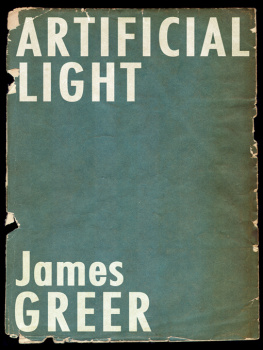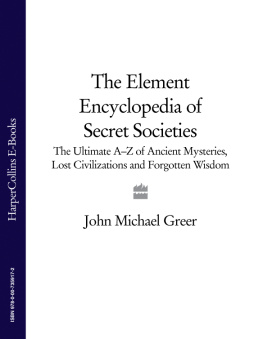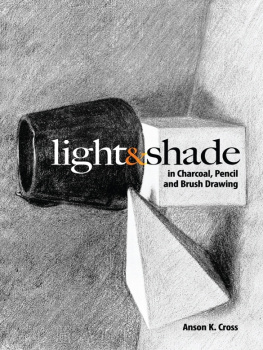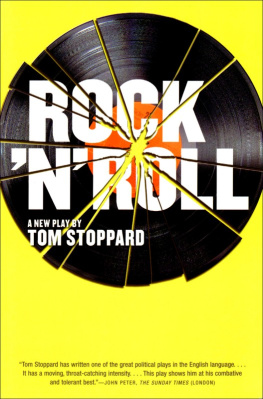Greer - Artificial Light
Here you can read online Greer - Artificial Light full text of the book (entire story) in english for free. Download pdf and epub, get meaning, cover and reviews about this ebook. year: 2012, publisher: Akashic Books, genre: Detective and thriller. Description of the work, (preface) as well as reviews are available. Best literature library LitArk.com created for fans of good reading and offers a wide selection of genres:
Romance novel
Science fiction
Adventure
Detective
Science
History
Home and family
Prose
Art
Politics
Computer
Non-fiction
Religion
Business
Children
Humor
Choose a favorite category and find really read worthwhile books. Enjoy immersion in the world of imagination, feel the emotions of the characters or learn something new for yourself, make an fascinating discovery.
- Book:Artificial Light
- Author:
- Publisher:Akashic Books
- Genre:
- Year:2012
- Rating:3 / 5
- Favourites:Add to favourites
- Your mark:
- 60
- 1
- 2
- 3
- 4
- 5
Artificial Light: summary, description and annotation
We offer to read an annotation, description, summary or preface (depends on what the author of the book "Artificial Light" wrote himself). If you haven't found the necessary information about the book — write in the comments, we will try to find it.
Artificial Light beats the bejeezus out of the last dozen Thomas Pynchons, the last nineteen Don DeLillos, and the last forty-three Kurt Vonneguts.Richard Meltzer
Stunningly written in prose that is poetic, gripping, and highly adventurous, Artificial Light may be the first American novel to successfully treat the alternative rock scene of the 1990s as a subject for serious literature.
James Greer, a novelist and screenwriter, has written for Spin, Tennis Magazine, Sunfish Holy Breakfast, and Paris Hilton. He is the author of Guided by Voices: A Brief History: Twenty-One Years of Hunting Accidents in the Forests of Rock n Roll (Grove, 2005). He lives in Los Angeles.
Greer: author's other books
Who wrote Artificial Light? Find out the surname, the name of the author of the book and a list of all author's works by series.
Artificial Light — read online for free the complete book (whole text) full work
Below is the text of the book, divided by pages. System saving the place of the last page read, allows you to conveniently read the book "Artificial Light" online for free, without having to search again every time where you left off. Put a bookmark, and you can go to the page where you finished reading at any time.
Font size:
Interval:
Bookmark:

This is a work of fiction. All names, characters, places, and incidents are the product of the authors imagination. Where names of actual dead persons have been used, these are fictional renderings and are not meant to bear any resemblance to actual persons bearing the same name.
Published by Akashic Books
2006 James Greer
eISBN-13: 978-1-617750-85-4
ISBN-13: 978-1-933354-00-2
ISBN-10: 1-933354-00-3
Library of Congress Control Number: 2005934826
All rights reserved
First printing
Little House on the Bowery
c/o Akashic Books
PO Box 1456
New York, NY 10009
Akashic7@aol.com
www.akashicbooks.com
Elle se plaignait damour, elle demandait des ailes.
Flaubert, Madame Bovary
To S.A.
The book you are about to read has had an unusual, though by now familiar, genesis. Even those who do not as a rule follow developments in the literary world will have been acquainted with the circumstances surrounding its discovery and subsequent celebrity, and doubtless will be drawn to the work by the sensational allure of those circumstances rather than by the prospect of wading through its authors complexly immature prose. Fiat Lux has, since the events circumscribed herein, become a cause, or at least an incident, rather than a writer, a shrewd foreknowledge of which development may be what caused her to instruct, in a postscript appended to the final notebook, that the manuscript be turned over to this university, which, after due consideration, has decided to publish Artificial Light through its own press.
Its contents are here reproduced for the most part in their original form. I have chosen to respectfully disagree with those who argued that judicious pruning of the manuscript would have produced a more readable, coherent work, in the belief that Ms. Lux, under whatever conditions she undertook to compose her book, assembled her words with some care, and that an underlying structural consistency will reveal itself to the patient reader. A more thoroughly edited version may well prove useful at some point, but in the opinion of this editor the first public manifestation of Artificial Light, which will inevitably color and shape both the immediate perception of the book and all future editions, shouldmustbe as faithful as possible, especially with regard to the four-part structure of its narrative. It is my hope that the mass of Fiats text will generate a gravitational field of serious scholarship and in so doing begin the slow, ineluctable process of drawing attention away from the lurid aspects of her case and toward the close study of what she has written.
I grant its not likely anytime soon that objectivity will be restored to the matter. Too many issues remain unresolved, including many connected to the book itself. Certainly, the way the manuscript was foundin twenty-one small spiral-bound notebooks handwritten in a tiny, tidy hand, with a remarkable absence of erasures or corrections, the notebooks stacked in sequential order at Kurt Cs residence, underneath an enormous window, the panes of which had been punctiliously and thoroughly smashedretains an aura of mystery, years after the fact. Crime scene investigators determined that the window had been broken from within, according to their report, publicly available to any interested party. Im not sure any of the details that report contains are telling. The panes of the window were smashed, the notebooks were found, confiscated by authorities, brushed for prints and tested for DNA, and when none of these forensic tools proved fruitful, the manuscript itself was scoured for cryptographic clues. Eventually the people assigned to investigate gave up, the notebooks were turned over to WUniversity, and the file was closedofficially, The Disappearance of Fiat Lux remains an open case, an unsolved mystery, but no one in a position to care does, any longerand so What Happened has passed from a criminal matter to a cultural matter, and as with all cultural matter, has dispersed over time to such a degree that what few facts were ever known with any certainty have mushroomed into folklore.
My interest is both more and less specialized. I am not a sociologist, I am not a student of folklore, and Im not much of a textual analyst. Im interested in the girl, Fiat Lux, and in what she wrotenot why, or how, or for whom, but what (and not what what means, either; thats not the job of this editionit is the job of this edition to allow others to figure that out, though). Because I think too little attention has been paid to the content of her writing, I have assigned myself the task, or at any rate lobbied to have the task assigned to me (the politics of the academic world are of little interest to the general reader), of editing and presenting this writing in as straightforward (i.e., un-annotated, unindexed, un-cross-referenced) a manner as possible.
The curriculum vitae of the woman who calls herself Fiat Lux in these pages, when purged of the accumulation of legend that surrounds her disappearance, is ludicrously brief: She was born sometime in the early 1970s, in Dayton, O, claims to have graduated from ACollege in Yellow Springs, O, claims to have worked as a librarian for the Dayton Public Library, and claims to have saved the world. None of these claims have been or can be verifiedespecially without identifying the woman behind the pseudonym, which has proved impossible, to date, in part because shes done an excellent job of disguising herself. Ms. Lux disappeared from the object of her salvatory labors sometime in the spring of 1994, and no further details have been uncovered, despite the best efforts of a troop of journalists and academics fascinated by the various aspects of her putative existence.
Some questions of fact are easier to resolve: a) it is true that Orville Wright lived in a mansion on Hawthorn Hill until his death in 1948. There is no way of knowing whether he was, in fact, an opium addict, although certainly no other source survives that could or would corroborate such a claim, and the diaries Fiat purports to have consulted have not been discovered; b) it is true that Kurt Calso lived at Hawthorn Hill, and that his body was discovered there in early spring of 1994. His death was ruled by the coroner a suicide by self-inflicted gunshot, and a substantial quantity of narcotics was found in his blood, according to the toxicological report obtained by us. As with any infamous public figure, rumors have abounded concerning the ways and means of his passing; there are those who insist, rather pathetically, that his death was a ruse and he still lives, fat and balding, on a paradisal island far from the rigors of fame; c) the sections attributed to Trip Ryvvers are probably fiction, as no book or manuscript of the title cited by Fiat seems to exist; having said that, many of the specific historical facts cited in these sections are ironically the easiest to validate; and most of them have proved accurate in their smallest detail; d) the Mary Valentine sections would also appear to be fiction, though we have identified an incident which in its broad outline corresponds to the accidental death of Michael Goodlife; but despite the repeated efforts of my research staff, no one who knew the person we have tentatively identified as Michael Goodlife will speak to us; e) Sean OHanlon was of course very much a real writer, and his long sad slide into insanity has been well-documented in the two biographies that have appeared in the past three years, prompted, possibly, by the renewed interest in OHanlons work as a result of Fiat Luxs passionate advocacy herein.
At the risk of appearing flippant, Im not sure that any of even this scant information is important. Certainly the question of whats real and whats fake in Fiats manuscript is unhelpful at best. Her list of Sources Consulted, appended here at the end of the text proper, contains a few books that do not appear to exist, or ever to have existed, a few that were inexplicably published years after this manuscript was discovered, and a few that, while undeniably extant, have eluded our efforts to pinpoint the results of their consultation in the text. Perhaps Ms. Lux meant to say that their influence was of a general nature, but we simply have no way of knowing. In other instances, she has imported whole paragraphs without attribution, sometimes from books not listed in the Sources Consulted, which can be rather annoying, from a purely editorial point of view. Treat the book as fiction (as a vocal minority of scholars would bid you do), and you will, I think, find much to enjoy and even admire, though you will sadly miss the essential point. That said, the factundeniable and yet indemonstrablethat Artificial Light is no more fiction than you or I, gets neither you or I anywhere we want to go.
Next pageFont size:
Interval:
Bookmark:
Similar books «Artificial Light»
Look at similar books to Artificial Light. We have selected literature similar in name and meaning in the hope of providing readers with more options to find new, interesting, not yet read works.
Discussion, reviews of the book Artificial Light and just readers' own opinions. Leave your comments, write what you think about the work, its meaning or the main characters. Specify what exactly you liked and what you didn't like, and why you think so.















